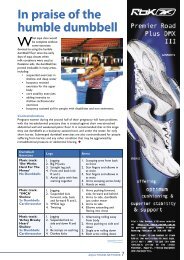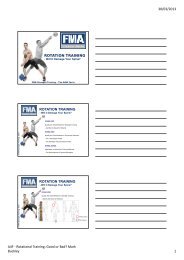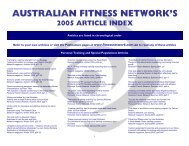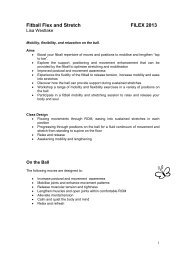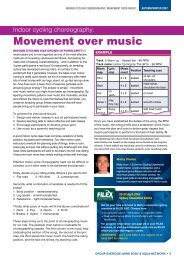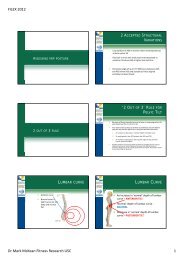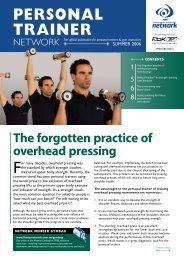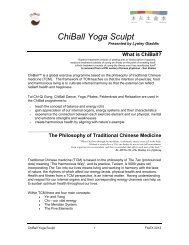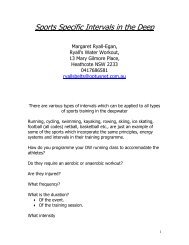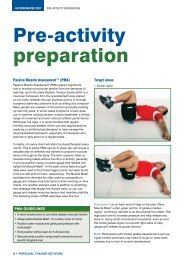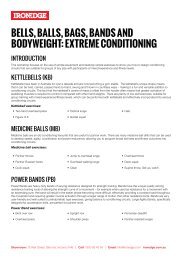CD - Australian Fitness Network
CD - Australian Fitness Network
CD - Australian Fitness Network
Create successful ePaper yourself
Turn your PDF publications into a flip-book with our unique Google optimized e-Paper software.
AUTHOR’S BIO<br />
TRAINING<br />
FLAT BENCH PRESS:<br />
THE GOOD, THE BAD AND<br />
THE SOLUTION<br />
Ulrik Larsen<br />
�Among those who keep up<br />
with sports science research,<br />
the standard fl at bench press<br />
is fast becoming the black sheep of<br />
gym exercises – and for good reason:<br />
it is widely reported as being the most<br />
common cause of shoulder injuries<br />
in the gym. Yet despite the growing<br />
recognition of this risk, the exercise<br />
remains very popular with personal<br />
trainers and strength and conditioning<br />
coaches. It is time for a serious<br />
reappraisal.<br />
The fl at bench press is an extremely<br />
good way to grow a big chest<br />
(pectoralis major), hence its abiding<br />
popularity with members and clients.<br />
The same levels of pectoral growth<br />
cannot be achieved with standing<br />
cable presses or single arm dumbbell<br />
presses on fi tballs, even though<br />
biomechanically they are profoundly<br />
safer, as they spread the load across<br />
numerous body parts. So, rather<br />
than try to outlaw an exercise that is<br />
likely to remain extremely popular, it<br />
makes sense to learn how to overcome<br />
its dangers with some intelligent<br />
modifi cation.<br />
POOR BIOMECHANICS FROM THE<br />
BENCH = POOR RESULTS + PAIN<br />
The high levels of injury associated<br />
with the fl at bench press are primarily<br />
22 NETWORK WINTER 2010 www.fitnessnetwork.com.au<br />
An <strong>Australian</strong> Sports Physiotherapist specialising in sports injury management, Ulrik has decades of experience<br />
working with personal trainers and their clients, including elite athletes and their coaches. His passion for giving fi tness<br />
professionals competence to manage clients with injuries led him to develop the Rehab Trainer course which is now<br />
delivered internationally through his network of similarly-minded physiotherapists. For more information visit<br />
www.rehabtrainer.com.au or call 0423 861 342.<br />
caused by the bench itself, and its eff ect<br />
on the movement of the shoulder joint.<br />
It is not uncommon to fi nd that a client<br />
will experience shoulder pain when<br />
performing the fl at bench press, but<br />
none if they are doing normal prone<br />
push-ups. This is because the eff ect of<br />
most benches is to severely restrict the<br />
movement of the scapula (also called<br />
the socket or the shoulder blade),<br />
thereby artifi cially exaggerating the<br />
movement of the glenohumeral (ball<br />
and socket) joint.<br />
Alongside pain, muscular<br />
development will be inhibited and<br />
distorted. Pectoralis minor will begin<br />
to dominate the press movement over<br />
pectoralis major, preventing the chest<br />
from developing as it should. The<br />
excessive glenohumeral movement<br />
(sometimes termed ‘lurching’) will<br />
ensure that the pectoralis major does<br />
not have a strong base from which to<br />
operate, again preventing its normal<br />
development. Instead the shoulders<br />
become rounded, and the anterior



